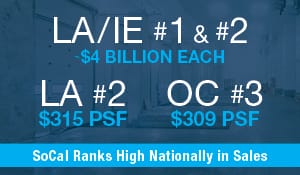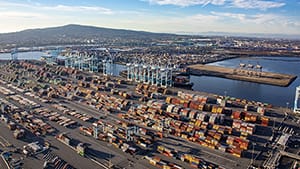
Like much of the country, the industrial market in Southern California is seeing a return to “normal.” Despite vacancy rates that have doubled or tripled in each of Voit’s markets year-over-year, they still remain historically low — between 2.57% (Orange County) and 4.87% (Inland Empire). All are below the national average, estimated to be around 5%–5.5%. Availability rates also continue to climb due to construction completions and more sublease space hitting the market. So rent growth has slowed considerably — which is a small victory for tenants, until one remembers that those seeking to renew or relocate will be paying a 40% to 60% premium over their pre-pandemic rental rates. Transaction activity has also stalled as institutional buyers remain on the sidelines, and companies seeking to own their real estate are still facing limited supply and lingering high-interest rates.
“I think we’re heading back to the norm,” says Randall LaChance, EVP/Partner, San Diego. “And what is that norm? You know it’s not 1% vacancy, it’s not 10% to 15% annual rent growth, it’s not tons of spec development, it’s not three tenants knocking on the door when you get a vacancy. It’s going to be 5% vacancy — which is not a bad market; it’s just not what it’s been for the last 2–3 years.”
Despite the predicted return to the norm, LaChance is encouraged by recent developments in the national economic picture. “I don’t want to say that there’s a lot more optimism, but there’s certainly less pessimism than there was a few months ago,” he affirms, pointing to the skyrocketing stock market (all three indexes recently hit record highs), the drop in the 10-year Treasury from five to just above four, and the indications from the Fed that they will drop interest rates multiple times this year. “And the Fed may have possibly pulled off the soft landing. At the end of the day, that’s the key — stability in the market. But we’re still in wait-and-see mode,” cautions LaChance.
Let’s look at sales and leasing in Voit’s markets, which include the Inland Empire, Los Angeles County, Orange County, San Diego County, and Mid Counties.
Capital Markets
 Despite the slowdown in investment sales in 2023, Los Angeles County and the Inland Empire were still number 1 and 2 in sales volume nationally, each with nearly $4 billion in sales, far ahead of the #3 market, Dallas, at $2.7 billion. California properties also topped the list in price per square foot, with the Bay Area leading the nation at $336 psf, followed by Los Angeles County ($315) and Orange County ($309).
Despite the slowdown in investment sales in 2023, Los Angeles County and the Inland Empire were still number 1 and 2 in sales volume nationally, each with nearly $4 billion in sales, far ahead of the #3 market, Dallas, at $2.7 billion. California properties also topped the list in price per square foot, with the Bay Area leading the nation at $336 psf, followed by Los Angeles County ($315) and Orange County ($309).
There was a significant pullback from institutional buyers in the markets in 2023, which continues into the opening quarter of 2024. As a result, private investors can now compete with the institutional capital that drove pricing for the last three years, according to Mike Hefner, SIOR, EVP/Partner, Anaheim. “A lot of assets were taken to the market with pricing expectations that weren’t realized, so either they didn’t trade or were traded well below expectations,” he explains. “So, the private investor is now able to secure assets because they’re not competing against the 30-day, all-cash institutional buyers. We’re now at a point where people on the sidelines are emerging in the marketplace.”
 Another group of buyers that is re-emerging are owner-users — who have been the bright spot in the industrial sector recently, according to Hefner. One of the positives for owner-users currently in the market is the steep drop in the SBA effective loan rate. A significant portion of owner-occupier sales in Southern California access the SBA 504 program, and with the nearly 100-point drop in the 10-year Treasury (the primary benchmark for setting commercial property mortgage rates), the SBA 504 25-year loan rate decreased by 77 basis points from a 2023 high of 7.13% in October to 6.36% in January.
Another group of buyers that is re-emerging are owner-users — who have been the bright spot in the industrial sector recently, according to Hefner. One of the positives for owner-users currently in the market is the steep drop in the SBA effective loan rate. A significant portion of owner-occupier sales in Southern California access the SBA 504 program, and with the nearly 100-point drop in the 10-year Treasury (the primary benchmark for setting commercial property mortgage rates), the SBA 504 25-year loan rate decreased by 77 basis points from a 2023 high of 7.13% in October to 6.36% in January.
Although institutional investors have pulled back significantly, it doesn’t mean they have left the market. Instead, they will closely watch what happens with interest rates, cap rates, leasing activity, and whether the economic resurgence has staying power before re-entering the arena. Garrett McClelland, SVP/Partner in the Irvine office, had this observation about how institutional investors are currently deploying their capital in his Voit Q4 Market Report editorial: “Investors have pumped the breaks on risky new developments but have actively been targeting well-positioned assets with income in place to mitigate risk’” he wrote. “I’m optimistic for 2024. Lower interest rates and a narrowing of the bid-ask gap will help fuel additional deal volume for both lease and sale transactions.” Hefner is also optimistic about capital markets and believes “we’ll see sales activity this year.”
Leasing
Following a couple of years of double-digit rent growth, Southern California industrial markets command some of the highest rental rates in the nation, with Los Angeles County leading the way at $1.84 psf. The good news is that rent growth in most markets has flattened to varying degrees, with the glaring exception of Orange County, which saw a 13.29% year-over-year increase in asking rates (and an increase to a whopping $425 psf in asking sale pricing). The remainder of the markets saw asking rents slowing to middle and low single digits, with the Inland Empire actually seeing a price drop from $1.51 to $1.41.
According to Voit brokers, rent is unlikely to drop in most markets, but landlords are now beginning to offer concessions, particularly to strong credit tenants willing to sign longer leases. And with the increase in vacancy and availability rates, McClelland observes that landlords are becoming more creative with tenant incentives, broker bonuses, and open houses to generate increased interest. Overall, with demand and supply in better balance than it has been in many years, competition for space has moderated. This reduced sense of urgency allows tenants to be more deliberate in their decision-making and hold out for space that truly fits their needs.
 One market that may see a surge in activity is Los Angeles County. In their Voit Q4 Market Report editorial, VP/Partner Selden McKnight and associate Jordan Haynes of the Anaheim office predict that the combination of the shortage of water in the Panama Canal combined with ongoing labor issues with the East Coast ports should continue to facilitate growth for the Los Angeles ports. Port activity began to increase in November, and port activity saw a 19% increase in monthly year-over-year activity for twenty-foot equivalent units (TEUs), the largest monthly year-over-year increase since June 2021.
One market that may see a surge in activity is Los Angeles County. In their Voit Q4 Market Report editorial, VP/Partner Selden McKnight and associate Jordan Haynes of the Anaheim office predict that the combination of the shortage of water in the Panama Canal combined with ongoing labor issues with the East Coast ports should continue to facilitate growth for the Los Angeles ports. Port activity began to increase in November, and port activity saw a 19% increase in monthly year-over-year activity for twenty-foot equivalent units (TEUs), the largest monthly year-over-year increase since June 2021.
Another observation that bodes well for the San Diego market and beyond is the trend to nearshoring and onshoring with U.S. manufacturers returning operations to North America. In his Voit Q4 Market Report editorial, Michael Mossmer, SIOR, SVP/Partner, San Diego, notes that as multinational corporations continue the nearshoring of their manufacturing in Tijuana, their subsequent need for product distribution on the United States side will bolster the Otay Mesa submarket, located in the southern district of San Diego. “This continued demand to locate manufacturing in Tijuana will help maintain a healthy absorption rate of new and existing industrial product in Otay Mesa and will help maintain upward pressure on industrial demand throughout San Diego County,” he writes.
Conclusion
Southern California’s industrial market is returning to a stable “new normal” with a more balanced supply and demand landscape and slower rent growth. LaChance believes that without some sort of economic slowdown like a recession or substantial reduction in GDP and employment growth, vacancy will remain low, and rents are unlikely to go down. “I don’t think we’re going to see that unless we go into recession, and as of right now, that doesn’t appear likely,” he predicts.
That being said, Southern California markets should remain resilient in 2024, and if the national economic conditions continue to improve, there should be more activity in the capital markets, particularly if the Fed makes good on its rate cuts.
For a more detailed market-specific analysis from our research team, visit the Voit Market Reports page.